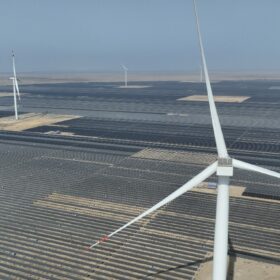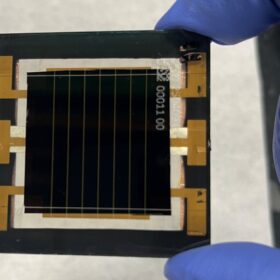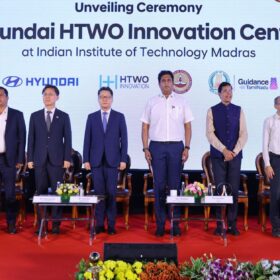Top News
“Energy storage will account for half our business within three years”: Geon vice president

Adani Green Energy Ltd achieves 15.8 GW of operational renewable energy capacity

Australia’s green hydrogen plan faces water shortage
Out now - pv magazine Global June edition
pv magazine Webinar

NREL, CubicPV achieves 24% efficiency for perovskite mini solar module

The Hydrogen Stream: IIT Madras, Hyundai to launch green hydrogen innovation centre
India installed record 21.9 GW of solar and wind capacity in H1 2025: JMK Research
Italy’s latest renewables auction attracts 17.5 GW of solar project proposals
Tata Power inaugurates green energy skilling centre in Delhi
Markets & Policy
Featured
What standards for agrivoltaics?
How is India’s power infrastructure evolving amid global supply chain shifts?
With renewable capacity expanding, grid upgrades underway, and policies fostering local supply chains, India is navigating a complex but promising energy transition.
India’s emerging role in EV battery recycling: Creating a circular economy
India is well-placed to advance the e-mobility circular economy in Asia against the backdrop of the fast-growing market and recycling strategies. Adopting the 5Rs—Reduce, Reuse, Repurpose, Remanufacture, and Recycle—can help in reducing resource depletion and waste.
“India on track to achieve 50% renewable energy milestone by year-end”: Union power minister
“India is on track to achieve the milestone of 50% renewable energy share in its total installed power generation capacity by the end of the year,” said union power minister Manohar Lal Khattar at the 11th edition of India Energy Storage Week (IESW) 2025.
Australian Clean Energy delegation visits India to further deepen their engagements
A 30-member Australian Clean Energy Delegation representing 22 companies, is visiting India from July 7 – 11, 2025 to showcase Australia’s innovative solutions across energy storage technologies, AI solutions for energy operations, solar technologies, green hydrogen, energy modelling and weather forecasting, education & capacity building and consulting.
Powering a greener future through India’s clean energy transition
As India adds more intermittent renewables like solar and wind to its energy mix, modernising the electricity grid becomes a priority. Grid expansion, integration of battery storage systems, and digital monitoring tools are critical to accommodate fluctuations in generation and demand.
Installations
NLC India to infuse INR 1,631 crore into renewable energy arm
India installed 17.4 GW utility-scale solar, 5.15 GW rooftop PV capacity in FY 2025: JMK Research
Rajasthan led the annual solar additions with 6.5 GW, followed by Gujarat (3.6 GW) and Maharashtra (2.3 GW).
Hindustan Power begins work on 435 MWp solar project in Uttar Pradesh
The 435 MWp solar power project in Lalitpur advances the state’s goal of 22 GW renewable energy capacity by 2026–27 while generating local jobs and promoting sustainable development.
JSW Energy commissions 189 MW solar and 72 MW wind power capacity
JSW Energy has commissioned 261 MW of renewable energy, taking its total installed capacity to 12.8 GW.
K2 Systems unveils new pitched roof mounting solutions
K2 Systems has introduced two new pitched roof mounting components for residential solar: the SingleHook 3S Light, made of aluminum and stainless steel; and the InsertionRail 2.0, an aluminum mounting rail.
Japan’s 24th solar auction concludes with average final price of $0.028/kWh
Japan has allocated 79 MW of PV capacity in its latest procurement exercise. The highest price in the auction was JPY 7.79 ($0.054) /kWh.
Technology
Featured
Photovoltaics for atmospheric water harvesting
Honeywell adds Li-ion Tamer for battery fire safety in buildings
Honeywell has acquired the Li-ion Tamer business from Nexceris, a leader in off-gas detection technology for lithium-ion batteries. Li-ion Tamer’s early warning technology detects battery off-gassing, which typically precedes thermal runaway, providing facilities with vital time to intervene before a battery fire starts.
AM Green acquires stake in Greenko from ORIX
The stake acquisition enhances AM Green’s upstream integration with Greenko, which runs over 10 GW of renewable and pumped storage assets and is building the world’s largest “Intelligent Energy Storage Cloud Platform.”
Solarium, NISE sign MoU to develop solar-based heating solutions for cold regions
Solarium Green Energy Ltd has signed a Memorandum of Understanding (MoU) with the National Institute of Solar Energy (NISE), under the Ministry of New and Renewable Energy, to jointly develop advanced solar-based heating technologies.
John Cockerill Hydrogen raises €116 million to drive global growth
The amount covers nearly all the funding required to accelerate the development of John Cockerill’s hydrogen business, including the rollout of next-generation pressurized alkaline electrolyzer technologies and international expansion.
The Hydrogen Stream: Toyota Kirloskar, Ohmium to co-develop green hydrogen microgrid solutions in India
The partnership will explore scalable and cost-effective green hydrogen microgrid solutions by combining Toyota’s expertise in proton exchange membrane (PEM) fuel cell technology with Ohmium’s modular and high-efficiency PEM electrolyzer systems.
Manufacturing
Featured
Longi unveils 34.58%-efficient tandem perovskite-silicon solar cell based on asymmetric self-assembled monolayer
First Solar uses quantum dots to boost module efficiency
Quantum dot technology promises to boost bifacial solar module output. The company entered into a supply agreement with specialist UbiQD.
Solarix Solar launches new terracotta solar panel
The Netherlands-based solar façade panel and mounting system provider has added a new terracotta rooftop module to its product range. It also announced it is expanding it sales network and boosting its manufacturing capacity after raising €5.5 million in financing.
First attempt to build tandem solar cells based on perovskite, transition metal dichalcogenide
Scientists in India have proposed to design new tandem solar cells using transition metal dichalcogenide as an absorber material for the bottom PV device. Their simulations showed these tandem cells may reach an efficiency of over 35%.
Shakti Pumps raises INR 292 crore to set up 2.2 GW solar cell and module factory
Shakti Pumps (India) Ltd has raised INR 292.60 crore through a qualified institutions placement (QIP). It will utilize the proceeds to establish a greenfield 2.2 GW solar cell and module manufacturing plant in Madhya Pradesh.
Gautam Solar secures California Energy Commission certification, extends US market presence
The California Energy Commission certification ensures Gautam Solar’s modules comply with stringent quality, safety, and performance standards required for solar installations in the State of California, the largest solar market of the United States.
Energy Storage
Featured
Oriana Power secures BESPA for 50 MW/ 100 MWh battery energy storage systems in Rajasthan
WoodMac: World needs 1.4 TW of grid-forming batteries by 2034
The data company says investments of $1.2 trillion in battery energy storage systems (BESS) will be required to support the installation of over 5.9 TW of new wind and solar capacity globally through 2034.
India Installed 341 MWh of battery energy storage capacity in 2024, says Mercom
India’s cumulative battery storage installations are expected to reach nearly 15 GWh by 2027
ACME Solar places order for over 3.1 GWh of battery energy storage system
ACME Solar has placed an order for more than 3.1 GWh of battery energy storage system (BESS) with global suppliers including Zhejiang Narada and Trina Energy.
World’s largest vanadium flow battery goes online in China
A giant solar-plus-vanadium flow battery project in Xinjiang has completed construction, marking a milestone in China’s pursuit of long-duration, utility-scale energy storage.
Narada Power secures 1.4 GWh energy storage order in India
Narada Power will supply its liquid-cooled energy storage system for a large solar PV project being developed by a leading private-sector power producer in India.
Opinion & Analysis
Featured
Bringing back-contact to the foreground
US solar panel price from India stable at $0.288/W
In a new weekly update for pv magazine, OPIS, a Dow Jones company, provides a quick look at the main price trends in the global PV industry.
India’s next solar frontier: Captive projects are powering industrial self-reliance
Industrial belts in Punjab, Haryana, Maharashtra, Gujarat, and Tamil Nadu are becoming hotspots for captive solar. The drivers vary from steep tariffs and policy incentives to strong ESG commitments by export-oriented businesses, but the result is the same: a distributed solar network powering India’s industrial economy.
The impact of module pricing on solar project viability: Trends and predictions
India’s solar sector faces rising module costs due to recent developments, including the imposition of anti-dumping duties on solar glass and China’s reduction in export rebates on solar modules, impacting project viability. These shifts underline the delicate balance between promoting local manufacturing, pursuing geopolitical strategies, and navigating the economic realities of global trade.
Why solar power can’t just be industries’ CSR afterthought
Companies that treat solar as a core part of their energy strategy, rather than a side initiative, often see these benefits play out with striking clarity. The investment case is strong. In most cases, payback happens within five to seven years. After that, solar becomes a net-positive contributor to the balance sheet.
Wafer producers scramble to stay afloat despite hydropower advantage
In a new weekly update for pv magazine, OPIS, a Dow Jones company, reports that FOB China wafer prices remained stable this week amid weak demand and low production. It says manufacturers continue to face margin pressure despite seasonal hydropower cost relief and traceability documentation premiums.




